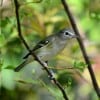 By Jim Stevenson,
By Jim Stevenson,
Is there anyone who would like to help stuff envelopes (with calendars) Wednesday morning, while we sit by the window with binoculars? Lunch is on the GOS. We’ll get together around 9 am. Leave when you need to. Amazingly, the Sunday morning field trip was EVEN BETTER than last week! We will NOT have one this week on account of the photo workshop. If there is ANYONE who is interested in the Florida Trip in December, PLEASE get with me immediately!
Your gallery is on various members of certain songbird families. Enjoy!
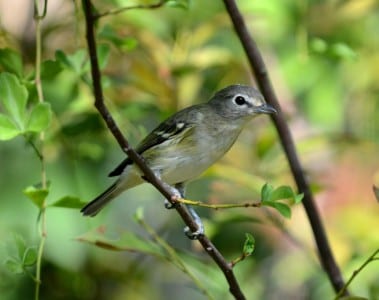
In a bit of excitement, a Cassin’s Vireo dropped into the yard the other day, a bird whose range is near ly two thousand miles from here. This used to be part of the species called a Solitary Vireo, lumped with our Blue-headed Vireo, and others. This Pacific Coast bird seems to have a habit of occasionally turning up on the UTC, and for some reason, I (and my yard) seem to attract them.
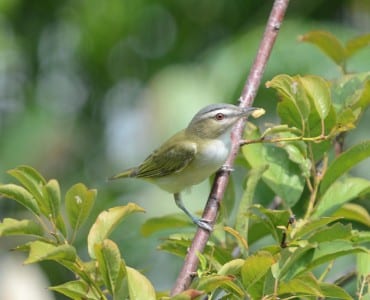
More typical of our area, this Red-eyed Vireo has found some lunch in a pupae, I think. This species has a well-marked head, but has the typical drab, vireo body. Can you see the segmentation on the juvenile arthropod? That reflects their ancestry of segmented worms (I am told). I have three of my professors from grad school on this list, so I’m sure I’ll hear from them when I make a booboo. This is the family Vireonidae, warbler- like songbirds with hooked bills. Their bills are more like flycatchers, but are cylindrical instead of flat like the ‘catchers. It is specialized for pulling caterpillars from crevices, and I can testify that when removed from mist nets, they bite hard!
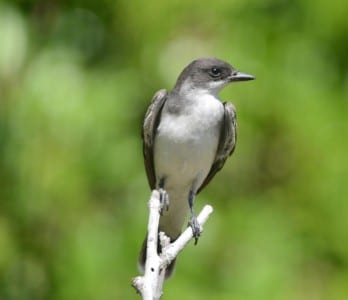
Kingbirds are loud, active flycatchers, a bit larger than most, which live in open areas and aggressively pursue raptors, cats, snakes and other predator-types. We get large numbers of this species is early fall, as does the Peninsula of Florida, including a flock estimated at over a quarter-million decades ago. I can hear the cries of the entomologists.
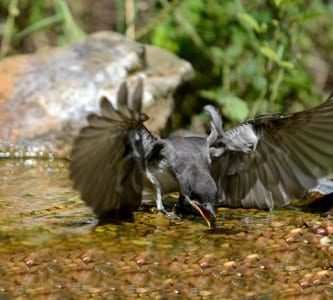
This Eastern Kingbird is trying to swoop onto the drip water and accomplish two goals: getting a sip of water and bathing. This is how flycatchers and vireos get wet, splashing into the water’s surface and flying away. They do not wade in like so many species of songbirds and others. Getting this shot wasn’t easy. Note the yellow on the inside of the gape. We see a lot of immature birds in the fall and if they make it back their first spring, they have a better chance of a long and happy life.
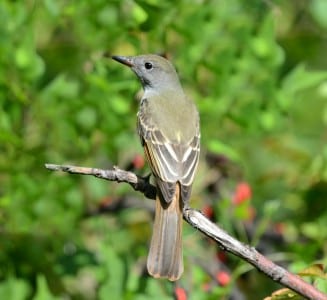
This is the back view of the Great Crested Flycatcher, one of the many soft-colored members of its family. If you look hard you can see a tiny bit of flesh color at the base of the bill, an excellent field mark to separate this species from other Myiarchus flycatchers of its genus. This species is normally the only one of its genus in eastern North America.
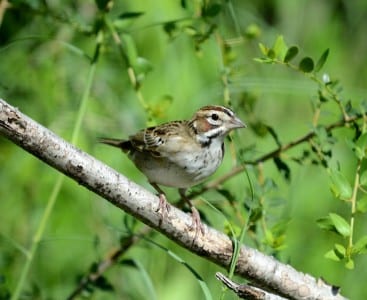
Lark Sparrows – what my buddy Vernon calls a “quail head” – is a very common and widespread species over much of the American West, though far less common in the East. The ruptive markings on the head are really bold for a sparrow, and it also has conspicuous white on the corners of the tail. This bird is both molting, as well as not a full adult yet, so it’ll look a bit better with time.
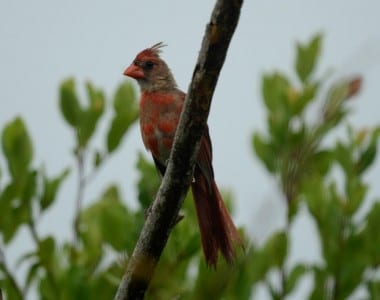
Speaking of molting, this is a young male cardinal getting into its adult male plumage. It needs to. I am so pleased to have this pair in my yard, as they weren’t here when I first moved in, and they also disappeared after Ike for several years. They are obviously a finch, with the conical bill, so they can crack grain, seeds and thumbs.
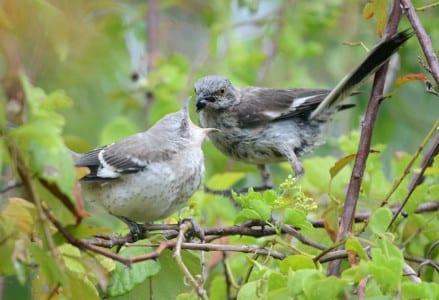
It is curious to me that this adult mockingbird in deep molt is feeding a fledgling mocker, and I have doubts about whether it’s even the chick’s parent. I didn’t see any mockers here in August, except the ones that were zipping past as migrants. I have often thought that molting birds were in a dead heat with juveniles for the ugliest bird award, and in August we have both. Maybe that’s why nobody birds then!
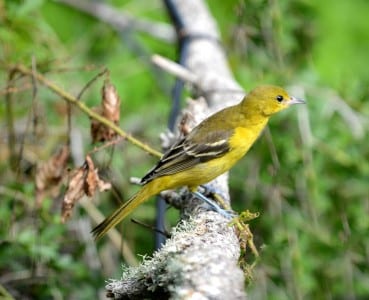
We are just besieged by Orchard Orioles in late August, but they sure disappear quickly in September. As circum-Gulf migrants, they follow the coast down Galveston from east to west, stopping at the good places to swipe berries and fruit. They are sometimes joined by Baltimores, although we didn’t have a good year for them this year. These orioles that have no orange – just yellow – are Orchards.
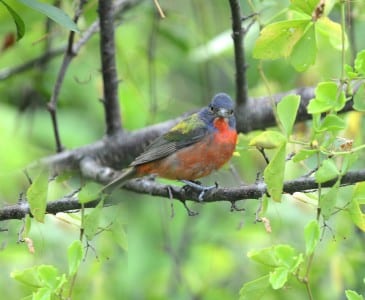
This Painted Bunting is a little ratty, but its colors are still nice. The blue head, green back and red underside dresses it up enough to be considered our Nation’s most beautiful bird. Obviously, the voters have never seen a Golden-winged Warbler, but I digress. This species nests in my yard, but has disappeared over much of the UTC during my 18 years here. However, they are still fairly common in the Hill Country.
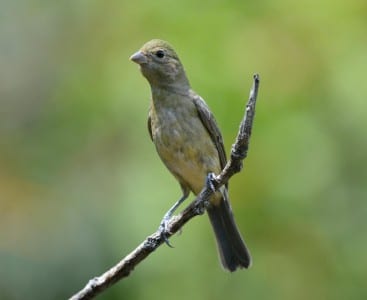
Not a spectacle of glamor, this eight-week-old Painted Bunting has never seen anything but my yard (but what else is there?). It’ll be tooling down to someplace like Costa Rica soon, but for now, it’s putting on fat and quietly creeping around the premises. This hint of green, or greenish-gray, eliminates all other female/immature buntings (like Indigo) and the finch bill tells you it’s not a warbler or some other songbird.

Our Nation’s earliest spring arrival can be seen heading south in “fall” at the end of May. Er go, this September bird is getting pretty late, as it’s almost never seen in October. She will probably spend a quiet winter on the Amazon with a few hundred thousand other martins, and be ready to claim a little, tiny box when she returns in early spring. It is, of course, a Purple Martin, not the Olive-sided Flycatcher my birding clients from Vermont called it.
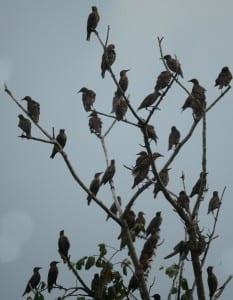
One of the problems with introducing animals like starlings is that they often have few natural enemies, and can become atrociously abundant. This is the case with Sturnus vulgaris (I didn’t name it). Perhaps the worst of their deeds has been flying into jet engines, crashing the planes. They are not only a similar size and shape as waxwings sitting…
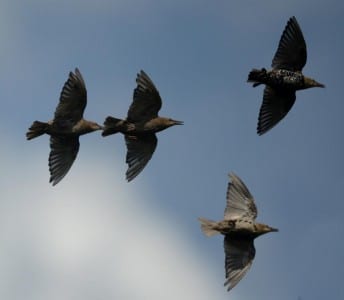
They look quite a bit like them in the air as well. The short, pointed wings are waxwing-like and they also have a rapid wingbeat. You can see the juvenile below is quite a bit different from the adult top right, as well as the two in juvenile plumage, top left. You can also see how clouds are not a very good background for flight shots.
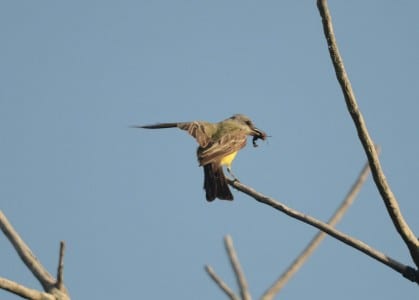
A bit of excitement last week was a Tropical Kingbird joining the Cassin’s Vireo, with a Prairie Warbler here with them for good measure. This hunter nailed (literally) a spiderkiller, and proceeded to bang it on the limb over and over. The chitinous exoskeleton of the wasp makes it hard to kill but the kingbird ain’t named that for nuthin. This kingbird is historically a scarce breeder of the Rio Grande Valley (and a tiny portion of Arizona) but has not only shown up in many parts of the Country, it even bred last year in town (Pelican Island).

Rare in Texas in fall, this Veery dropped into the yard for a day last week. Note this rich color on top, typical of this species. They also don’t have the bold spots on the chest of the other transient thrushes, and nests much further south than the other spotted thrushes. This is also a young bird, and research shows that these youngsters tend to wander more than adults, and also have a much higher mortality rate. We wish him well!

 Posted in
Posted in 
























